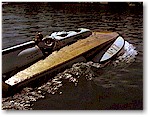
Miss Chrysler Crew
Automotive-powered Miss Chrysler Crew to Debut [1966]
 |
| U-77 Miss Chrysler Crew |
The mighty Goldcuppers with their Rolls Royce Merlin and Allison jillion cubic inch engines are thrilling to watch, but prove very little, except maybe to reinforce the old adage that you can fly a barn door, given enough power. With only X number of these engines available anymore, this field has become pretty exclusive.
Bill Sterett of Owensboro, Kentucky, the national seven litre champion for 1964-'65, has decided to break into this club the hard way. He is going to challenge the mighty thunderboats with his own version of a Goldcupper powered by two blown 426 Chrysler hemis. Two Chryslers amount to only 852 cubic inches, against the 1700 cubes of the converted aircraft engines. At first glance, this whole project may seem impossible, but let's look into it.
Bill is counting on three factors to get the job done against. the bigger and more powerful boats: a different hull design, lighter weight and higher engine revolutions. the new boat, Miss Chrysler Crew, is a scaled-up version of his highly successful seven litre hull, Miss Crazy Thing. The original design, as well as the design of the new larger hull, was done by Henry Lauterbach of Portsmouth, Virginia. Sterett drove Miss Crazy Thing to the national seven litre high point championship in 1964 and '65. The boat won Miami's International Grand Prix for three consecutive years and holds the world's record for seven litre closed-course competition, not to mention the kilo record of 151.403 mph. The 426 Chrysler ran the entire 1965 season without a breakdown; a set of rings and a couple of bearings were all the replacements made for the entire year. The boat design and engine reliability have been proven. With this impressive background, the next step is into the larger Miss Chrysler Crew.
The new hull is a duplicate in design, but is 40% larger. Still it is smaller than most unlimiteds, being 29 feet 2 inches long, with a beam of 11 feet 10 inches. Other hydros in this class range from 30 to 35 feet in length. Unlike most unlimiteds, it does not have a high tail with adjustable trim tabs. Bill considers this unnecessary. It is also the only unlimited with a non-trip chine on the inside sponson. The 45-degree angle (versus the usual 90 degrees) reduces the pitching effect in the turns and allows the boat to slide more. Sterett's U-77 weighs approximately 6000 pounds, compared with an average of about 7000 for other unlimiteds.
The two Chrysler hemis, placed in tandem and both facing forward, weigh 1504 pounds and have a special Casale-designed gearbox of 168 pounds. By comparison, the Rolls Royce aircraft engine weighs about 1750 pounds and requires a gearbox weighing in excess of 300 pounds.
The gearbox is located between the blown fuel-injected engines. Thus the forward engine feeds power to the gearbox from the rear, and the aft engine from the front. The big boats overdrive 3 to 1. Miss Chrysler Crew swings a 14-inch prop, as opposed to 12½ and 13 wheels used with the aircraft engines. Sterett believes the 14-incher is more effective and better suited to the weight of his boat. Tests have indicated 10 percent less slip with this combination.
Sterett reports that a great many people have told him that it is impossible to compete successfully in the Unlimited class with a hydro powered by automotive engines. But the Kentuckian says in-water tests with the new boat have convinced him it will be competitive in all aspects of racing — speed, acceleration and cornering. Says he: "We're prepared to try the impossible."
From what I have seen of Goldcup racing, I think Sterett has a real winner going for him. The big "thunderboats" are so hopped-up that their margin of reliability is very poor. After a six-lap, 18-mile heat, about half are dead in the water, with one or two running good and the rest limping along. The racing is done in heats, with points earned by the finishing position in each heat. The overall winner is determined by who has the largest total of points after all the heats are run. These things can't run any distance races. Bill needs only reliability to garner enough seconds and thirds in the heats to emerge the overall winner if trouble hits the top contenders. Let's watch this one; as a seagoing hot rodder he has all our best wishes.
(Reprinted from Erick Rickman's "Roostertales" column in Hot Rod, August 1966, pp.94-95)
Hydroplane
History Home Page
This
page was last revised
Thursday, April 01, 2010
.
Your comments and suggestions are appreciated. Email us at wildturnip@gmail.com
© Leslie Field, 2001